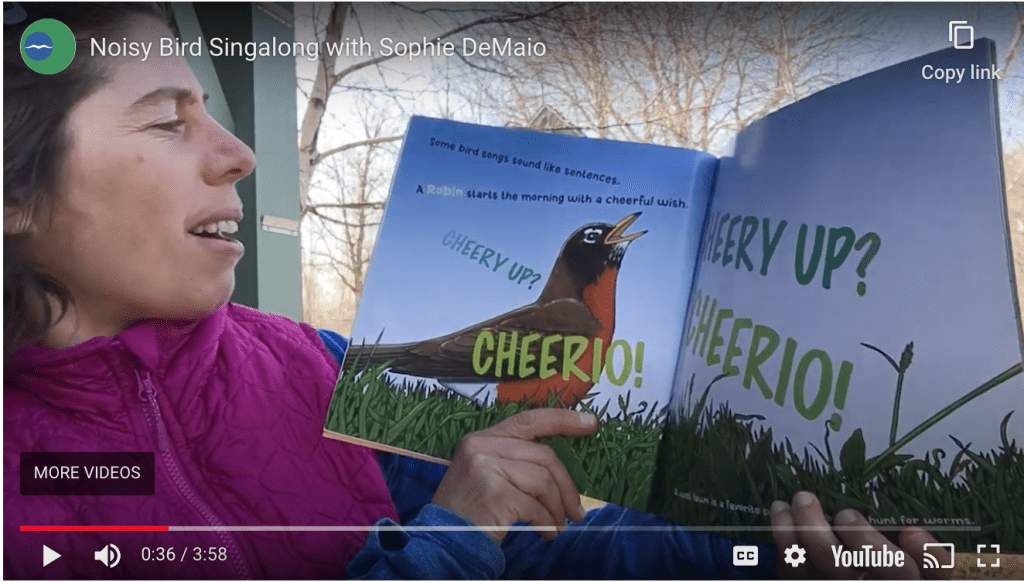
Have you been hearing more birds lately? Each spring, as resident songbirds begin to sing and new migrants join in by the day, I vow anew to become better at identifying birds by ear. If your child has already mastered barnyard animal sounds (or even if they haven’t!), why not try learning some bird sounds together?
You can get started with this read-aloud of Noisy Bird Singalong by John Himmelman with Sophie DeMaio, who teaches Family Fun programs at Fields Pond in Holden. Afterwards, check out the playlist of bird sounds that accompanies this book!
As you head OUTSIDE, try:
- Download Cornell Lab’s Merlin Bird ID app. Not only will it help you identify the birds you see by asking a series of questions and then giving you a list of likely candidates, but you can use it to search for a bird and play sound clips, too.
- Even if you can’t identify a bird, try to imagine what it is communicating. Does it sound panicked or scolding? These alarm calls can clue you in to the presence of predators or other perceived threats. See if you can spot the cause, which may be a nearby hawk, prowling cat, or even your own sudden appearance too close to a nest site.
- Try answering the birds! Can you whistle “fee-bee” back to a chickadee? Or caw in response to a crow? Imitating what you hear will also help you distinguish between sounds. Try listening for birds in your neighborhood, or look up some of your favorites on Merlin. (Bonus points to anyone who can make a passable puffin sound!)
To keep learning more when you head INSIDE, consider:
- BirdNote is a daily radio show with very short (typically two minutes) episodes that you can catch on NPR or listen to online. This episode is a great introduction to birding by ear because it separates out the sounds made by four salt marsh species, then gives you a chance to hear them in the context of a whole, noisy habitat. I also love this episode, which plays the song of a Pacific Wren (the western counterpart to our Winter Wren) at normal speed, and then slowed down to ¼ speed. It’s fascinating to hear all the details that our less finely attuned ears miss!
- Older kids (and adults) may enjoy the Cornell Lab’s Bird Song Hero, a game that teaches you to match bird sounds to a visual representation of the sound (spectrogram). Give it a shot because when you complete the game you’ll unlock an offer to download a free pack of bird sound mp3s.
- Lastly, here’s a game that can help you learn bird sounds and burn a little energy. Begin by listening to and comparing the sounds of two common birds. I like to start with Black-capped Chickadee and Blue Jay. Once everyone feels pretty comfortable distinguishing between the two, place labels (or better yet, pictures) of the two birds on opposite sides of the room.. Then, play one of the two sounds. Everyone should quickly move to the bird they think it is. Announce the answer, then have them return to the middle for the next sound! Keep playing at a pretty rapid pace, adding or swapping in new birds as you master the first few. I like to emphasize that this isn’t about being right every time — it’s a fun way to practice and learn.
Our educators, scientists, advocates, and naturalists are committed to keeping you connected to the natural world as we deal with the coronavirus situation together. Check in every weekday on our Connections page for family activities, parent/teacher tips, backyard birding, nature exploration at our sanctuaries, and more.
